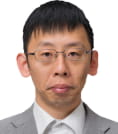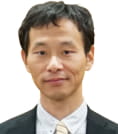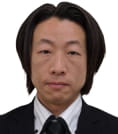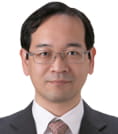- JST Home
- /
- Strategic Basic Research Programs
- /
 PRESTO
PRESTO- /
- project/
- Nanoengineering on Mechanical Functions of Materials/
- [Nanomechanics] Year Started : 2019
[Nanomechanics] Year Started : 2019
Tomonari Inamura
Geometry and shape memory properties of nano-scaled martensite microstructure
Researcher
Tomonari Inamura

Professor
Institute of Innovative Research
Tokyo Institute of Technology
Outline
The geometrical condition for the compatible nano-scaled martensite microstructure which is formed by coherent connection of domain walls is revealed in a newly developed TiNi based shape memory alloy. The relationships among the distance from the compatible condition, microstructures and the macroscopic properties are extracted from experimental data and geometrical analysis. A guideline to design high-performance shape memory alloy by controlling the geometry of nano-scaled martensite microstructure is developed.
Takashi Uneyama
Mesoscale Coarse-Grained Modeling with Pseudo Degrees of Freedom
Researcher
Takashi Uneyama

Associate Professor
Graduate School of Engineering
Nagoya University
Outline
Polymers and softmatters form various structures at nano and mesoscales, and such structures strongly affect their macroscopic material properties. To investigate how these structures affect macroscopic material properties by theoretical models and computer simulations, the coarse-graining method is useful. The coarse-graining reduces the degrees of freedom of a target system and thus it makes the theoretical models simple and the computer simulations efficient. In this project, we construct a new coarse-graining procedure which incorporates pseudo thermodynamic degrees of freedom. In this procedure, some physical quantities such as the diffusion coefficients and the interaction potentials are interpreted as time depdendent and fluctuating pseudo degrees of freedom.
Toshiyuki Kondo
Investigation of extrinsic and intrinsic size effects dominating mechanical strength of metallic thin film
Researcher
Toshiyuki Kondo

Lecturer
Graduate School of Engineering
Osaka University
Outline
The film thickness (extrinsic size) and the size of the microstructure (intrinsic size) have a great influence on the mechanisms and mechanics of the deformation and fracture in metallic thin films. In this project, I will realize to form metallic films of which thicknesses (on the order of 10-1,000 nm) and microstructures (single-crystalline, polycrystalline) are controlled independently. I will also develop in situ nanoscopic observation/analysis fracture toughness and fatigue crack propagation testing techniques for thin films. By separating the influences of the thickness and microstructure (extrinsic and intrinsic size effects) on the mechanisms and mechanics of the deformation and fracture in metallic thin films, I will elucidate the responsible factors and mechanisms for the strengthening of the metallic films.
Kenji Shinozaki
Fabrication of ultra-low brittle glass by designing nanoscale compositional fluctuation
Researcher
Kenji Shinozaki

Senior Researcher
Nanomaterials Research Institute
The National Institute of Advanced Industrial Science and Technology
Outline
This study propose a new process that can control fluctuations of glasses desirably, and establish it as a new material design for nano-microscale structure in glasses. By designing the deformation and fracture behavior on the nanoscale, this realizes an ultra-low brittle glass that suppresses the generation and propagation of cracks.
Ryo Suzuki
Elusidation of mechanical properties for protein crystals based on dislocation theories
Researcher
Ryo Suzuki

Associate Professor
Department of Science
Yokohama City University
Outline
Protein crystals are composed of protein molecules with huge sizes and complex shapes. The molecular size is an order of nanometer as compared with that of angstrom in common materials. Additionally, they contain a large amount of intra-crystalline water among protein molecules, in contrast to ordinary crystals. The behavior of the intra-crystalline water in the crystals is qualitatively classified into two types: one is bound water held around each protein molecules and the other is free water moving through the crystals. From such unique characteristics, protein crystals are expected as new bio-porous materials in the next generation. In this research, the mechanical properties of protein crystals will be characterized for practical applications as novel materials.
Masakazu Tane
Lattice dynamics of fluctuation-induced atomic shuffling and its correlation with deformation behavior
Researcher
Masakazu Tane

Professor
Graduate School of Engineering
Osaka Metropolitan University
Outline
I construct the thermodynamics, statistical mechanics, and lattice dynamics of dynamic atomic shuffling in diffusionless displacive phase transition driven by quenched-in compositional fluctuations. Furthermore, I construct the atomistic models of plastic deformation and deformation-induced phase transition, taking into account the dynamic atomic shuffling, and consequently, I establish a new theory for mechanics of materials, which focuses on the dynamic atomic shuffling.
Ryuichi Tarumi
Multiscale mechanics of materials manifold
Researcher
Ryuichi Tarumi

Professor
Graduate School of Engineering Science
Osaka University
Outline
This project aims to develop a theoretical framework for multiscale mechanics of crystalline solids which includes lattice defects such as dislocations and disclinations. Our formulation is based on the strain gradient elasticity and differential geometry on the materials manifold. The new theory considers both nonlocality and nonlinearity on an intermediate configuration and which will be implemented into the numerical analysis using NURBS-based IGA. Large scale computer simulations will be conducted to reveal the size-dependent deformation mechanism in a nano-scale region. The goal of this project is to open up a new frontier for designing of engineering materials from a multiscale viewpoint.
Tomohito Tsuru
A new mechanical theory with local degree of freedom of dislocation core leading to novel functionality
Researcher
Tomohito Tsuru

Principal Researcher
Japan Atomic Energy Agency
Outline
Mechanical properties of many of solid materials are in general dominated by dislocation motion. Recently, unprecedentedly-excellent mechanical properties were discovered in some specific alloys systems, and the properties were found to be related to some form of unique feature of dislocation structure. In this study, I plan to propose a mechanical theory based on the local degree of freedom of dislocation core and develop a new method to describe the dislocation behavior including core effect at finite temperature. The newly-developed theory and a sequence of computational approaches open us new possibility to explore strategically the novel functionality of materials beyond the conventional materials.
Eita Tochigi
Atomic scale analysis of deformation and fracture phenomena
Researcher
Eita Tochigi

Associate Professor
Institute of Industrial Science
The University of Tokyo
Outline
In this study, a MEMS-based experimental system for in situ mechanical test is developed and applied to atomic-scale direct observations of deformation and fracture phenomena of crystalline materials by transmission electron microscopy. In order to precisely control test parameters, such as load, temperature and strain rate, the experimental in situ observations will reveal mechanical responses of crystalline materials at the atomic level under various mechanical conditions. It is aimed to contribute to the establishment of new nanomechanics theories.
Atsutomo Nakamura
Multiscale evaluation of the effect of light irradiation on mechanical properties of inorganic semiconductors
Researcher
Atsutomo Nakamura

Professor
Graduate School of Engineering Science
Osaka University
Outline
Recently, we reported that light irradiation affects mechanical properties such as ductility or brittleness in inorganic semiconducting materials. However, little is known about the effect of light irradiation on such mechanical properties as most of advanced semiconducting materials are too small to evaluate by conventional techniques. Therefore, the aim of this study is to establish multiscale measurement systems including nanoscale measurement systems, to systematically measure the effect of light irradiation on mechanical properties, and to reveal the mechanism on how and why light irradiation affects the mechanical properties.
Yohei Miwa
Development of Functional Polymeric Materials via Dynamic Ionic Crosslinks
Researcher
Yohei Miwa

Professor
Faculty of Engineering
Gifu University
Outline
It is known that ionic elastomers with dynamic ionic crosslinks exhibit unique behaviors such as self-healing, enhanced fatigue, fracture resistance, and ultrastretchability. In the ionic elastomers, the ionic moieties attached at the polymer chains are continually hopping between ionic aggregates at room temperature. Thus, the crosslinked structure is not permanent because the network dynamically rearranges. In this work, the relationship between the molecular structure and the dynamic nature of the ionic crosslinks is studied in detail to establish the molecular design concept that controls the elastomer’s functions on demand. Furthermore, the ionic network rearrangement is remarkably accelerated by the CO2 gas exposure. In this work, novel functional materials that utilize the CO2 gas are also going to be developed.













